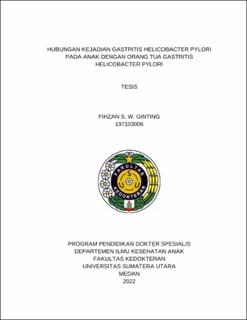| dc.contributor.advisor | Supriatmo | |
| dc.contributor.advisor | Hasibuan, Beby Syofiani | |
| dc.contributor.author | Ginting, Fihzan S W | |
| dc.date.accessioned | 2025-01-15T03:54:24Z | |
| dc.date.available | 2025-01-15T03:54:24Z | |
| dc.date.issued | 2022 | |
| dc.identifier.uri | https://repositori.usu.ac.id/handle/123456789/100130 | |
| dc.description.abstract | Background: Helicobacter pylori infection is one of the causes of gastritis. Therefore, the diagnosis of gastritis caused by H. pylori must be established as early as possible to prevent chronic infection. The spread of H. pylori is mostly through oral-oral or faecal-oral. In this situation, the interfamilial transmission of H. pylori infection is one of the accesses for infection transmission, especially at home.
Objective : This study aims to examine the relationship between H. pylori gastritis in children and H. pylori gastritis in their parents.
Methods: This research is an analytical study with a cross-sectional approach. The research was conducted at the gastrohepatology polyclinic, inpatient ward of RSUP. H. Adam Malik Medan and auxiliary hospitals in Medan during the study period. Each child with complaints of gastritis and parents was examined for Campylobacter-like organism test (CLO). The analysis was carried out using the Mann Whitney test and the Fischer Exact test. P value <0.05 was considered significant.
Results: From 96 samples of children and their parents who met the inclusion and exclusion criteria, the results of the CLO test showed that H. pylori infection was found to be positive in 51 children (53.1%) who had gastritis. Meanwhile, H. pylori infection was also found in 37 children's fathers (38.5%), and 59 children's mothers (61.5%). A significant relationship was found between the incidence of H. pylori infection in fathers and children with H. pylori infection in children (p=0.017). Meanwhile, there was no incidence of H. pylori infection in the child's mother and the child's parents with the incidence of H. pylori infection in children (p-values 0.572 and 0.227, respectively).
Conclusion: There is a relationship between the incidence of H. pylori infection in the father of the child and the incidence of H. pylori infection in the child, but not in the mother and both parents. | en_US |
| dc.language.iso | id | en_US |
| dc.publisher | Universitas Sumatera Utara | en_US |
| dc.subject | Helicobacter pylori | en_US |
| dc.subject | Gastritis | en_US |
| dc.subject | Children | en_US |
| dc.subject | Parents | en_US |
| dc.title | Hubungan Kejadian Gastritis Helicobacter Pylori pada Anak dengan Orang Tua Gastritis Helicobacter Pylori | en_US |
| dc.title.alternative | The Relationship of Helicobacter Pylori Gastritis in Child with Parents Helicobacter Pylori Gastritis | en_US |
| dc.type | Thesis | en_US |
| dc.identifier.nim | NIM197103006 | |
| dc.identifier.nidn | NIDN0021086506 | |
| dc.identifier.nidn | NIDN0008107409 | |
| dc.identifier.kodeprodi | KODEPRODI11711#Ilmu Kesehatan Anak | |
| dc.description.pages | 121 Pages | en_US |
| dc.description.type | Tesis Magister | en_US |
| dc.subject.sdgs | SDGs 3. Good Health And Well Being | en_US |


